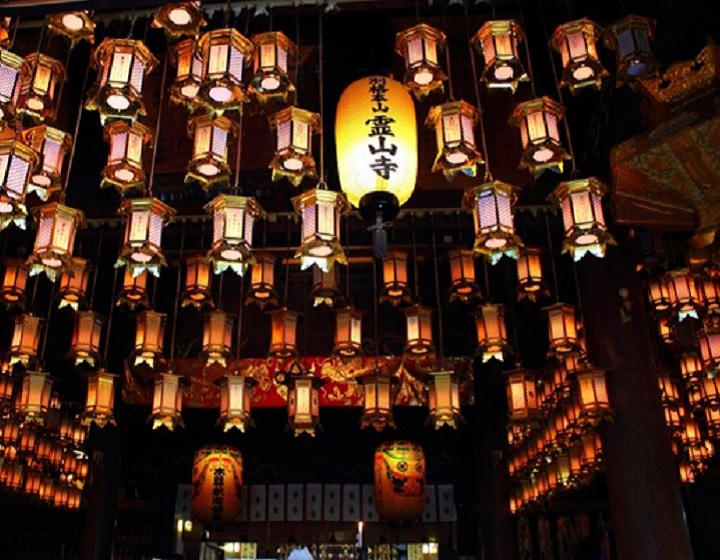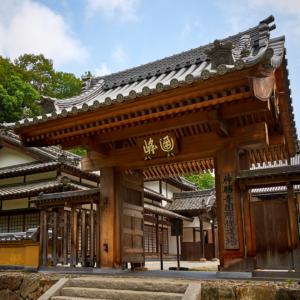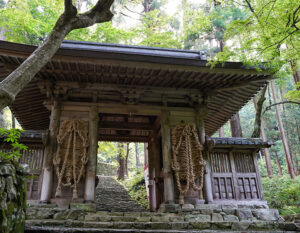The Shikoku pilgrimage covers 88 sacred sites related to Kobo Daishi scattered throughout the four prefectures of Shikoku. In addition to faith, many people have started the pilgrimage for sightseeing, health improvement, or just to enjoy the outdoors. Ryozenji Temple in Naruto City, Tokushima Prefecture, is the first temple on the Shikoku pilgrimage. Many people visit the starting point of the pilgrimage with prayers and thoughts in their hearts.
Shikoku was a Mecca for ascetic practices.
In recent years, there has been a bit of a boom in pilgrimages to sacred sites. There are numerous pilgrimage routes throughout Japan, including the 33 sacred sites in the western part of the country, the 33 sacred sites in the Bando region, and the Kumano Kodo Ise Route, and many people, especially seniors, are visiting these sacred sites.
Among these, the 88 sacred sites of Shikoku are probably the most popular, with a history of more than 1,200 years and a total length of 1,460 km, making it a grand pilgrimage route, and is recognized as a Japanese Heritage site. The pilgrimage to the 88 sacred sites in Shikoku is also called “Ohenro” (pilgrimage). The origin of this term is that Shikoku, with its steep mountains, is far from the capitals of Nara and Kyoto, and was called “Hendo,” a place suitable for ascetic practices. It is thought that the name later changed to “henro.
Starting from Naruto City, the gateway to Shikoku
The Shikoku pilgrimage is basically made in the order of the number of the temples on the pilgrimage route: Awa (Tokushima Prefecture), Tosa (Kochi Prefecture), Iyo (Ehime Prefecture), and Sanuki (Kagawa Prefecture). Reizanji Temple is the starting point of the pilgrimage. Naruto City, where the temple is located, is the gateway to Shikoku from Osaka and Hyogo via Awaji Island, and Reizanji Temple is located in the southwestern part of the city.
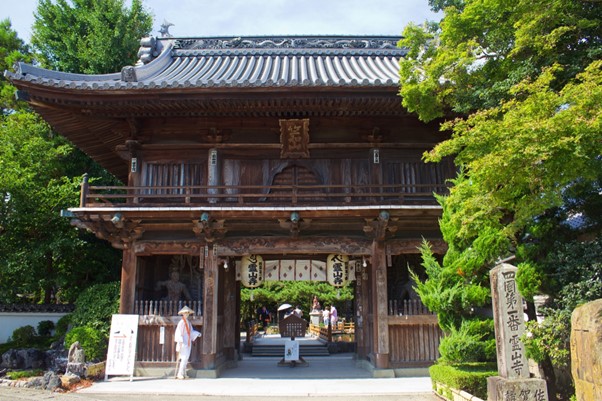
Ancient temple that suffered two fires
Reizanji Temple was founded in the Tempyo period (710-794). It is said that the temple was founded by the priest Gyoki, who was trusted by Emperor Shomu, at the order of the Emperor. The temple was once lined with majestic buildings and prospered as one of the three great monasteries of Awa during the Muromachi period (1336-1573), but it was completely destroyed by fire in 1582 when Motochika Chosokabe, a feudal lord of the Awa domain, burned the temple down in a military fire. The temple was restored by Mitsutaka Hachisuka, the lord of the Awa domain, but in 1891, the buildings were again destroyed by fire, except for the main hall and the pagoda. The Reizan-ji we see today was reconstructed to its original state over a period of more than 100 years.
Who is Kobo Daishi, the creator of Shikoku Sacred Sites?
The person deeply associated with Reizan-ji Temple is Kobo-Daishi (Kukai), a monk of the early Heian period who was also known as a famous writer. He is still affectionately called “Kobo-san” or “Odaishi-san,” and is a superstar in the Buddhist world.
Born in 774 in Zentsuji City in present-day Kagawa Prefecture, Kobo-Daishi traveled to Tang China in 804 as an envoy to the Tang Dynasty and studied esoteric Buddhism for two years. After returning to Japan, he founded the Shingon sect of Buddhism and devoted himself to propagating Buddhism in Japan. He also engaged in educational and social projects, including the establishment of the Shugei Shuchi-in, an educational facility for the people, and the construction of a reservoir for agricultural use in Kagawa Prefecture.
A Culture of Hospitality Rooted in the Local Community
Initially, Shikoku pilgrims were mainly ascetic monks, but as the faith in Kobo-Daishi grew, people from all over Japan and the world began to visit. The appeal of the Shikoku pilgrimage lies in the fact that it is open to anyone, regardless of religion, nationality, gender, age, etc., who can start a pilgrimage at any time.
One of the reasons why the Shikoku pilgrimage has captured the hearts of people is the “hospitality culture. The entire community supports the Shikoku pilgrimage by offering free sweets, drinks, lodging, etc. to the pilgrims, and by giving them support such as, “Good luck,” “Thanks for your hard work,” etc. This is a very natural practice. This warm custom, which has continued throughout the long history of the pilgrimage, provides the energy for the pilgrims to continue their arduous journey.
Worship in the style of a pilgrimage
While it is fine to visit the temple in a normal way, those who wish to start a pilgrimage or feel like a pilgrim should wear the minimum pilgrimage attire, including a white robe, a vajra cane, a kesa (priest’s robe), and a sugegasa (bamboo hat).
The vajra staff is a 1.5-meter-long white wooden staff, a sacred tool that is believed to be an incarnation of Odaishi. When resting, wash the tip of the staff and hold it in the palm of your hand, and do not take it with you to the toilet or other unclean places. Sugegasa, a straw hat, is used as a shade from the sun or as an umbrella. The phrase “Dougyouninin” written on the hat means that you are always with Odaishi-san.
The beads, scripture book, sutra book, osamefuda, incense sticks, candles, lighters, and other personal belongings are carried in a zutabukuro (headabukuro), but a large, comfortable backpack can be used instead.
Pilgrimage goods can be purchased at the Information Desk next to the parking lot of Reizanji Temple.
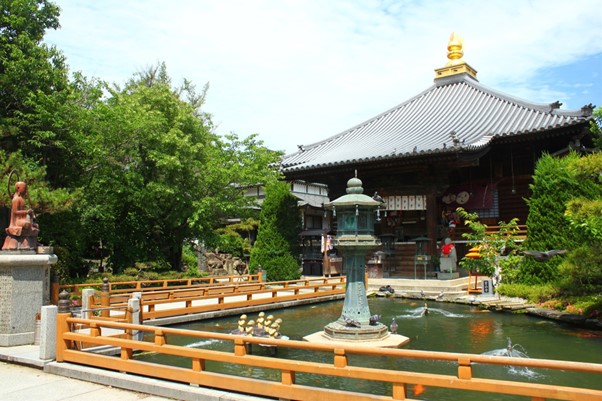
Precincts of the temple warmly welcome visitors
The nearest station to Reizanji Temple is Bando Station on the JR Kotoku Line. As soon as you get off the train, you will see people here and there dressed in white and wearing hats.
A 10-minute walk from the station brings you to the temple grounds through the Niomon Gate, a gate with a stately irimoya roof. To the left is the Kannon (Goddess of Merriment), a water fountain, and a bell tower, and to the right is the Hosei Pond with Nishikigoi carp swimming in it. Six child statues praying on the surface of the water to a statue of Jizo Bosatsu near the pond are somehow adorable. The solemn yet relaxed atmosphere of the temple makes one feel the depth of “Ichiban-san’s” nostalgia.
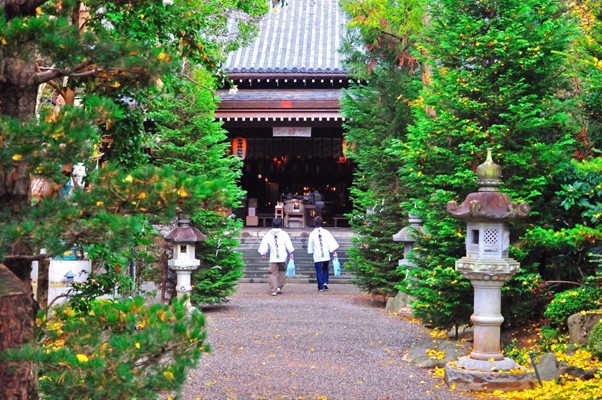
The majestic main hall echoing with sutra chanting.
After purifying our hands and mouths at the water closet, we struck the bell once in the bell tower as a sign that we had visited the temple. We then entered the main hall at the far end of the temple grounds.
The main hall was remodeled in 1964 to coincide with the 1,150th anniversary of the founding of Shikoku, and was constructed by adding an inner sanctuary to the worship hall. The main statue of Shakyamuni Nyorai is a seated statue of 4 feet tall (about 120 cm) holding a jade in his left hand. The statue is said to have been carved by Kobo Daishi during his training. Other statues enshrined in the temple include a triad of Jizoson Bosatsu, a seated statue of Binzuru Gyoja, and a Nosatsu Daishi made of solidified votive tablets.
The ceiling of the main hall is filled with many hanging lanterns, and the soft light illuminates the hall in a fantastic manner. A dynamic dragon painting on the ceiling in the center of the hall of worship adds to the mystique of the space. As you join your hands together amid the smoldering incense and the echoes of sutras read by the pilgrims, your heart will naturally become tighter.
A hall dedicated to a jet-black Odaishi-san
If you follow the pilgrim’s procedure, you will want to visit the Daishi Hall after the main hall. In this neat square-shaped hall facing Houshoike Pond, you can see a jet-black statue of Kobo Daishi.
Thirteen Buddhas calmly watching over the deceased and their ancestors
To the left of the main hall is a hall dedicated to 13 life-size statues of Buddha. The thirteen Buddhas are said to be the thirteen Buddhas who watch over the deceased and guide them to paradise, and worshippers who come to make offerings to their ancestors and the deceased seem to worship them with particular devotion.
Among the thirteen Buddhas, only Fudo Myoo is in the adjacent Fudo Hall. His eyes are wide open and he has an angry expression on his face, which is an expression of his heart to strictly teach and guide sentient beings, and is said to be beneficial for dispelling troubles and warding off evil spirits.
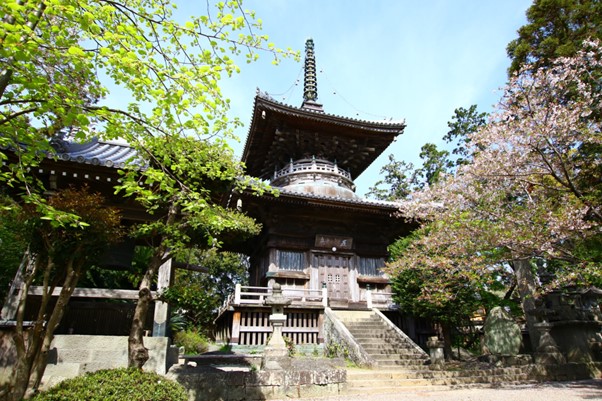
The oldest pagoda in the temple. The stately Daboto Pagoda
Between the Thirteen Buddhas Hall and the bell tower rises the Dabotoho Pagoda, which still retains the appearance of the pagoda as it was about 600 years ago. It is a two-story wooden pagoda with the lower part square and the upper part circular like a bowl, and inside the pagoda is enshrined Gochi-no-Torai (five wisdom Buddhas). Although the interior of the pagoda cannot be seen, its stately appearance, which evokes a sense of history, attracts the attention of visitors even from the outside.
Kannon, the Goddess of Mercy, is popular for bringing various kinds of luck.
The Kannon (Goddess of Mercy) for marriage, which stands quietly on the left side of the Niomon gate by the water fountain, is a popular spot for visitors to visit. It is believed to bring not only a man and woman together, but also health, work, and various other types of relationships. The key is to pray sincerely while purifying yourself with water as well as offering money.
After visiting all the halls, ask for a red seal at the sutra office next to the information desk. This will encourage you to begin your Shikoku pilgrimage, and it will also be a memory to cherish after your journey is over.
Kobo-Daishi taught that each person should strive to live a life that makes full use of his or her abilities and talents. This is a teaching that transcends religious boundaries, is easy to understand, and can be understood by us today. Reizanji Temple is filled with such power that one can feel its teachings firsthand and step into a new self with a refreshed feeling.



